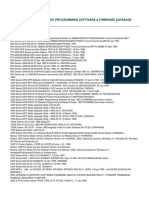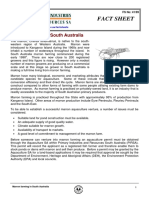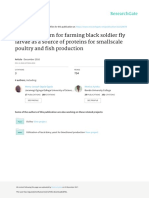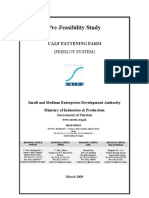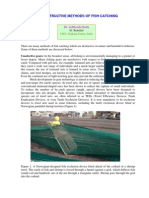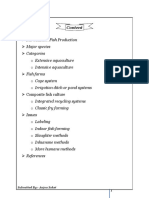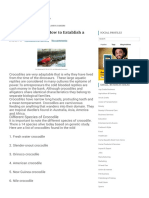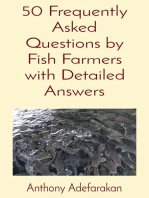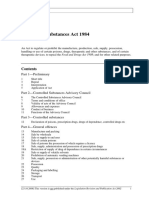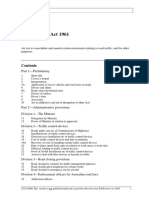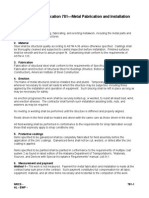Professional Documents
Culture Documents
Biology of Yabbies (Cherax: Destructor)
Biology of Yabbies (Cherax: Destructor)
Uploaded by
p25digital2Original Title
Copyright
Available Formats
Share this document
Did you find this document useful?
Is this content inappropriate?
Report this DocumentCopyright:
Available Formats
Biology of Yabbies (Cherax: Destructor)
Biology of Yabbies (Cherax: Destructor)
Uploaded by
p25digital2Copyright:
Available Formats
June 2000
Biology of Yabbies (Cherax AS0004
destructor) ISSN 1441-1199
Compiled by Fiona Withnall, Melbourne
Attempts to improve the farming of yabbies using purpose
built ponds will increase productivity however, a cost
benefit analysis is necessary and shall be based on realistic
production return estimates.
A basic but sound understanding of the animal’s anatomy,
physiology and behaviour is an essential pre-requisite to
successful yabby farming.
Information presented in this Aquaculture Note represents
only the most basic aspects of biology specific to C.
destructor and it is recommended that further literature,
including the references listed at the end of this Series
Note be read to obtain a more complete understanding of
Common Name: Yabby
the subject if you are contemplating a successful
Family: Parastacidea aquaculture venture.
Scientific Name: Cherax destructor (Illustrated)
Habitat
Status: Native, Freshwater
The yabby, Cherax destructor, is a semi-aquatic freshwater
crayfish commonly found in a wide range of habitats
Introduction throughout most of Victoria and New South Wales,
The freshwater crayfish commonly termed the yabby, including low-lying swamp ground, streams, rivers and
Cherax destructor, is often referred to as an ideal species dams. The most wide spread species of freshwater crayfish,
for aquaculture in Victoria. While production estimates are the yabby may also be found in southern Queensland,
varied, the 120 licensed farmers in Victoria produced 10 South Australia, and parts of the Northern Territory.
and 25 tonne of yabbies during 1995-1996. Prices for Yabbies are generally found in areas where oxygen levels
yabbies are influenced by demand, quality and size of are high and where there is plenty of vegetation.
product, with live yabbies falling into the mid to upper Adapted to a wide range of temperatures, the yabby is able
price range for shellfish. to survive in water temperatures between 1°C and 35°C
Yabby farming is often carried out at the lowest and easiest however, when water temperatures drop below 16°C the
level, known as “extensive” aquaculture. The production yabby falls into a state of partial hybernation where
system is simple and initial cost of farming is low as most metabolism, feeding and growth virtually cease.
farmers utilise existing dams that have been built for the Temperatures higher than 35°C will result in cessation of
watering of agricultural livestock. Once established in growth and eventually mortality. The ideal temperature
dams, yabby populations often become self-sustaining and range for optimum growth is between 20°C and 25°C.
very little needs to be done by the farmer to enhance Yabbies are able to tolerate a wide range of dissolved
production. oxygen levels and elevated salinities. Research has shown
Although the initial cost of farming is low and that they are capable of surviving in sea water for
establishment of yabbies in dams is relatively simple, approximately 48 hours however, high salinity levels will
issues such as uncontrolled breeding, post harvest handling result in increased stress on the individual. Growth will
and maintainence of a high quality product for market, often cease in salinities over 8 parts per thousand (ppt),
need to be considered. Live yabbies that are quality which is equal to approximately one quarter that of
assured attract the highest prices on the domestic and seawater, and mortalities will occur as salinity levels
international markets. increase. Dissolved oxygen levels are also important. As
© State of Victoria, Department of Natural Resources and Environment 2002 Page 1
Biology of Yabbies (Cherax destructor) AS0004
dissolved oxygen decreases, feeding and therefore growth, including Cherax. There are 30 species of Cherax
also decreases. throughout Australia, of which marron (C. tenuimanus),
Hence, good feeding activity and optimal growth are redclaw (C. quadricarinatus) and yabbies (C. destructor)
achieved when salinity levels are lower than 8 ppt and are are the most well known and the most popular aquaculture
dependent on healthy, well oxygenated waters. species’
Yabbies are commonly found on muddy or silted bottoms As for all crustaceans, yabbies do not have a skeleton
and are rarely found in clear water habitats, preferring (internal bone structure), but have an exterior hard shell,
water with moderate levels of turbidity. Muddy waters known as an exoskeleton. Easily distinguished from the
afford some protection from predators such as fish and true spiny freshwater crayfish which is characterised by the
birds giving the yabby a better chance at survival. presence of spines on the exoskeleton, the yabby has a
smooth shell. The colour of the shell varies greatly
Description: depending on the location, season and water conditions in
which the yabby is found. Colour will also vary from
All freshwater crayfish belong to one of three taxonomic
individual to individual in one location. They are usually a
families. Two of these, Astacidae and Cambaridae, occur
drab olive, dun or light brown colour, but have also been
only in the northern hemisphere of Australia. The
found to range from black, ochre-yellow and brown to red
remaining family, Parastacidae, is restricted to the southern
and blue.
hemisphere and contains 13 different genera (or groups)
Figure 2: Anatomical Characteristics of the Yabby, C. destructor
© State of Victoria, Department of Natural Resources and Environment 2002 Page 2
Biology of Yabbies (Cherax destructor) AS0004
Anatomy Reproduction
The basic anatomical characteristics of the yabby are Reproduction in yabbies is primarily related to water
illustrated in Figure 2. The body of the yabby may be temperature and day length. Research has shown that
broadly divided into two sections; the abdomen (tail) and mating begins in the spring and early summer when water
the cephalothorax (head). In yabbies, the tail meat, which temperatures reach above 15°C and day length has
is important to the farmer, makes up 15-20% of the total increased. Spawning reaches its peak between October and
body weight when they have been headed and shelled. The January. Females often spawn two or more times in the one
head, and other internal organs, is protected by the season.
carapace and armoured at the front with a strong, pointed During spawning, the male yabby places a spermatophore
rostrum. The major sensory organs for crayfish are the between the female’s fourth and fifth pair of walking legs.
large feelers or antennae and the finer, more central feelers The female breaks open the spermatophore and mixes the
known as antennules. The eyes, although quite prominent sperm with the eggs she expels. The fertilised eggs are
in the head, are of little use in the murky environment in placed within the “brood chamber” where they become
which the yabby lives. Thus, the antennae and antennules firmly attached to the pleopods.
act in place of the poor eyesight as touch and taste sensors,
Fertilised eggs may be identified by their colour.
locating potential food as well as sensing changes in water
Approximately 2 mm in length and oval in shape, the
quality parameters such as temperature and salinity.
fertilised eggs are usually olive green in colour. The
The abdomen is divided up into six segments that are number of fertilised eggs carried by the female ranges from
individually encased in hard shell. A flexible membrane 100 to 300 for a young female, to more than 1000 for an
joining each segment allows the yabby to move relatively older (larger) females.
unhindered. Appendages located on the underside of
A female carrying eggs beneath her tail is said to be in
abdominal segments two to five are known as pleopods (or
“berry”. A berried female will actively work to keep eggs
swimmerets). These are very important for female crayfish
cleaned and well oxygenated, removing any mortalities or
as the edge of each pleopod is lined with fine hairs, or
foreign particles with her fifth pereiopods. As the eggs
setae, to which they attach their eggs.
develop they undergo a series of larval stages, taking
The appendages found on the sixth segment are larger than approximately 19 to 40 days to hatch. The length of time
the pleopods and are referred to as uropods. These, along taken for the eggs to hatch is entirely dependent on
with two central flaps and the terminal abdominal segment temperature. In water temperatures of 20°C, the eggs will
(the telson), form the tail flap that is used to create the hatch within 40 days. As temperature increases, the length
thrust that moves the yabby quickly through the water. of time taken to hatch will decrease until water
Females also utilise the tail flap as a device to protect the temperatures reach 30°C. Temperatures above 30°C will
eggs during incubation, forming a temporary “brood adversely affected both the adult and the juvenile.
chamber” by folding the tail under her body.
The young remain within the “brood chamber” after
The sex of yabbies can be determined externally by the hatching from the eggs for a number of weeks, undergoing
position of the reproductive or genital openings. The male three distinct larval phases before emerging as juvenile
gonopores, or sexual organs, are located at the base of the yabbies. Once the young leave the female, she is
fifth pair, or rearmost pair, of walking legs (pereiopods) immediately able to spawn again, if environmental
while the female gonopores are found at the base of the conditions permit.
third , or middle, pair of legs (see Figure 3). Breeding
maturity is reached when the yabby is approximately 6-10 Moulting:
cm in length.
Yabbies grow by a process known as “moulting”. Moulting
is the process of shedding the old shell (exoskeleton) and
growing a new one in its place. The new shell is soft and
prior to it hardening, the yabby will take up and store water
within it’s body tissues thus effectively artificially
expanding it’s size and ‘stretching’ the new shell. The
water is expelled from the body once the new shell has
hardened. The overall effect is that the yabby now has a
shell bigger than it’s actual size into which it can then
grow. In newly hatched yabbies, moulting may take place
every couple of days. The frequency will decrease as the
yabby gets older until it will only moult once or twice a
year.
The hardening of the shell is achieved by drawing calcium
Figure 3: Location of Reproductive Organs for Crustaceans
from deposits in the body and from the surrounding water.
Calcium is stored in the body by reabsorbing it from the
old exoskeleton prior to moulting and depositing it in two
© State of Victoria, Department of Natural Resources and Environment 2002 Page 3
Biology of Yabbies (Cherax destructor) AS0004
calcareous deposits in the stomach wall known as Yabbies are a popular bait for fishermen and are becoming
gastroliths. Yabbies often eat their discarded exoskeleton increasingly popular as a restaurant menu item both within
after moulting in order to conserve calcium. The calcium is Australia and overseas.
then redeposited into the new exoskeleton in order to
harden it. Definitions:
Juvenile crayfish are approximately 0.02g upon hatching. Exoskeleton - hard supporting external structure of
Under favourable conditions, a juvenile yabby will grow arthropods and some sponges. The exoskeleton is formed
rapidly, gaining around 0.5 to 1.0 gram in the first 60 days. from calcium.
Moulting several times, the juvenile will continue to grow Gastrolith - calcareous deposit located within the stomach of
rapidly until it reaches sexual maturity within 12 months crustaceans. Calcium is stored in this way just prior to a
(50 to 100 grams). Individual growth is highly variable, moult in order to conserve calcium reserves.
and the maximum size of around 320 grams for adult Gonopore - Reproductive, or genital, opening.
yabbies will be reached within 2 to 3 years. Minimum Omnivore - animal that eats both plants and animals.
marketable size for yabbies is 30 grams and may be
reached in around 6 months. Pereiopod - walking limb of crustaceans. There are five pairs
of walking limbs found on the cephalothorax.
Feeding: Pleopods - Swimmerets found on the underside of each
abdominal segment of crustaceans.
Yabbies are omnivorous, but primarily vegetarian,
favouring rotting leaves and plant detritus. They are Setae - chitinous hair, or bristle, found along the edge of the
opportunistic feeders, eating just about anything when they pleopods of crustaceans.
are hungry including vegetables, fish food, fish, manure of Spermatophore - a number of sperms enclosed in a sheath of
any type, plants, wood and meat. gelatinous material.
It should be noted that yabbies are also cannibalistic, Swimmeret - small paired appendage present on the first five
particularly if they are in overcrowded situations or if there abdominal segments of crustaceans. Swimmerets are possibly
is insufficient natural food available. Animals that have used by females to attach fertilised eggs during incubation.
recently moulted are more susceptible to the cannibalistic Telson - the unpaired terminal abdominal segment of
nature of their neighbours as they are extremely vulnerable crustaceans.
to attacks from others at this time. This is an important Uropod - Fan-shaped paired appendage found on the final
consideration when establishing an aquaculture venture in abdominal segment of crustaceans. The uropod is used in
farm dams. swimming.
Yabbies are a nocturnal species. Feeding behaviour is
mostly controlled by the amount of light filtering through Recommended Reading:
the water and it is often found that the greatest periods of Geddes, MC, Mills, BJ & Walker, KF (1988) Growth of
activity occur shortly before dawn and just after dusk. Australian Freshwater Crayfish Cherax destructor under
Water temperature also plays an important role in the level Laboratory Conditions, Australian Journal of Marine and
of activity. At the temperature extremes, feeding rate will Freshwater Research 39, pp 555-568.
decrease as will metabolic rate which will result in reduced Groves, RE (1985) The Crayfish: Its Nature and Nurture,
growth. Fishing News Books.
Jones, C. 1990. Crayfish Biology - Getting down to basics.
Other facts:
Australia Fisheries Aquaculture Special: Reclaw,
The burrowing behaviour of C. destructor is a cause for 49(11):pp 3-7
concern for farmers. Yabbies are capable of digging very
Lawrence, C. 1995. Yabbies, Cherax albidus. Fisheries
deep burrows which can be 50 cm to two meters deep
Department of Western Australia. No. 4.
depending on the species. Burrows are connected by
access shafts to the water. In the event of the water drying Smallridge, M. 1990. Biology and Farming of the Yabbie.
up, the yabby is able to survive over summer in the South Australian Department of Fisheries, Research
burrows. Unfortunately, this behaviour may also destroy Branch
the integrity of dam walls causing problems for farmers.
The main predators of yabbies are aquatic birds and fish This publication may be of assistance to you but the State of Victoria
species. Farmers often find that bird species such as and its officers do not guarantee that the publication is without flaw
of any kind or is wholly appropriate for your particular purposes
cormorants, herons and the ibis are common pests while and therefore disclaims all liability for any error, loss or other
Murray cod and Callop are the main fish predators. Carp consequence which may arise from you relying on any information
often compete with yabbies for food sources and may act in this publication.
to displace yabbies from their habitat through their
foraging activities. Invertebrates such as dragonfly larvae,
chironomid larvae and some beetles often predate on
juvenile crayfish.
© State of Victoria, Department of Natural Resources and Environment 2002 Page 4
You might also like
- Tilapia Farming in Cages and PondsDocument44 pagesTilapia Farming in Cages and PondsAnime log100% (1)
- Eliminate Factors Inhibiting Redclaw: Farming From Reaching Its Full PotentialDocument140 pagesEliminate Factors Inhibiting Redclaw: Farming From Reaching Its Full PotentialPanjul NugrohoNo ratings yet
- Icom Programming Guide 2018Document13 pagesIcom Programming Guide 2018MikeNo ratings yet
- Moto Master DatabaseDocument41 pagesMoto Master Databasep25digital2No ratings yet
- MarronDocument11 pagesMarronp25digital2100% (1)
- Channel Catfish Broodfish and Hatchery ManagementDocument8 pagesChannel Catfish Broodfish and Hatchery Managementapi-3737467No ratings yet
- Aquaculture 05 PDFDocument16 pagesAquaculture 05 PDFfdlabNo ratings yet
- Redclaw Biology & Aquaculture BookDocument123 pagesRedclaw Biology & Aquaculture BookiringokantNo ratings yet
- CrayfishDocument1 pageCrayfishbroddy1No ratings yet
- Research Method To Manage Pathogenic of Cherax QuadricarinatusDocument50 pagesResearch Method To Manage Pathogenic of Cherax QuadricarinatusvinyspNo ratings yet
- Fish FarmDocument10 pagesFish FarmSamuel FanijoNo ratings yet
- How To Start Catfish Farming at Home-Backyard Fish FarmingDocument2 pagesHow To Start Catfish Farming at Home-Backyard Fish FarmingFolajimi AleshinloyeNo ratings yet
- Fact Sheet: Marron Farming in South AustraliaDocument11 pagesFact Sheet: Marron Farming in South Australiap25digital2No ratings yet
- FISH FARMING TECHNOLOGY: The Use of Feed in Recirculating Aquaculture Systems (RAS)Document4 pagesFISH FARMING TECHNOLOGY: The Use of Feed in Recirculating Aquaculture Systems (RAS)International Aquafeed magazineNo ratings yet
- Crustacean Farming - Ranching and CultureDocument465 pagesCrustacean Farming - Ranching and CultureDennis GarrettNo ratings yet
- COMMON NAME: Common CarpDocument3 pagesCOMMON NAME: Common CarpringpieceNo ratings yet
- Fish Farming: Name: ClassDocument16 pagesFish Farming: Name: ClasscucaimuoiNo ratings yet
- Kenya Market Led Aquaculture Programme Business Cases CompressedDocument18 pagesKenya Market Led Aquaculture Programme Business Cases CompressedMkulima HodariNo ratings yet
- Catfish Farming Business Plan BY Aka Peace Otaoghene 18/ENG01/002 IN Chemical Engineering Department FOR GST 212: EnterprenuershipDocument10 pagesCatfish Farming Business Plan BY Aka Peace Otaoghene 18/ENG01/002 IN Chemical Engineering Department FOR GST 212: EnterprenuershipCliffordNo ratings yet
- An Open System For Farming Black Soldier Fly Larvae As A Source of Proteins For Smallscale Poultry and Fish ProductionDocument7 pagesAn Open System For Farming Black Soldier Fly Larvae As A Source of Proteins For Smallscale Poultry and Fish ProductionAndres Alejandro CamargoNo ratings yet
- Tilapia Fish CageDocument5 pagesTilapia Fish CageMark Idol MarceloNo ratings yet
- Calf Fattening FarmDocument32 pagesCalf Fattening FarmAns Shaheer100% (1)
- Destructive Methods of Fish CatchingDocument4 pagesDestructive Methods of Fish Catchingapi-3803371100% (1)
- Subsistence Fish Farming in Africa A Technical Manual 10.2013 3Document294 pagesSubsistence Fish Farming in Africa A Technical Manual 10.2013 3Delfina MuiochaNo ratings yet
- Cat Fish Business PlanDocument45 pagesCat Fish Business PlanEFENo ratings yet
- Aquaculture Funmilayo IbigbemiDocument40 pagesAquaculture Funmilayo IbigbemiAbiodun AliNo ratings yet
- Goat FarmDocument38 pagesGoat FarmgavinilaaNo ratings yet
- IntroductionDocument29 pagesIntroductionHasun Malinga100% (1)
- Red Swamp CrayfishDocument21 pagesRed Swamp CrayfishmalamskiNo ratings yet
- Paua Reseeding: The Benefits ofDocument16 pagesPaua Reseeding: The Benefits offdlabNo ratings yet
- Redclaw Crayfish AquacultureDocument67 pagesRedclaw Crayfish AquacultureBBC3096100% (1)
- Principles of Ruminant Production and Health Herd ManagementDocument16 pagesPrinciples of Ruminant Production and Health Herd ManagementHermione MalfoyNo ratings yet
- Fish ProductionDocument34 pagesFish Productionit rewa100% (1)
- Home Mail News Sports Finance Weather Games Groups Answers Screen Flickr More Omg! Shine Movies Music TV Health Shopping Travel Autos Homes MobileDocument11 pagesHome Mail News Sports Finance Weather Games Groups Answers Screen Flickr More Omg! Shine Movies Music TV Health Shopping Travel Autos Homes MobileNancy DanielNo ratings yet
- Maaif Aquaculture ManualDocument246 pagesMaaif Aquaculture Manualcrispusmugabi0% (1)
- Grasscutter Farming BusinessDocument8 pagesGrasscutter Farming BusinessOpirex100% (1)
- Production of Artemia SalinaDocument25 pagesProduction of Artemia SalinaAurenio RibeiroNo ratings yet
- Crocodile Farming: How To Establish A Crocodile Farm Small Business IdeasDocument6 pagesCrocodile Farming: How To Establish A Crocodile Farm Small Business IdeasAmbaNo ratings yet
- Cattle FatteningDocument1 pageCattle FatteningRejie Canny CariasoNo ratings yet
- Portable Farms™ Aquaponics System PricesDocument5 pagesPortable Farms™ Aquaponics System Pricessoy_bartoleteNo ratings yet
- Sustainable Crab Industry Development in Surigao Del SurDocument12 pagesSustainable Crab Industry Development in Surigao Del SurHannah Joy F. FabelloreNo ratings yet
- Rudimentary Fish Farming Guide For BeginnersDocument46 pagesRudimentary Fish Farming Guide For BeginnersOpirex100% (1)
- Fish Farm ProposalDocument14 pagesFish Farm ProposalMichael Odiembo100% (1)
- 2008 Fishery Management Plan For Regulating Offshore Marine Aquaculture in The Gulf of MexicoDocument443 pages2008 Fishery Management Plan For Regulating Offshore Marine Aquaculture in The Gulf of MexicoCuitla0% (1)
- Why Do Angora Rabbit Farming ?Document17 pagesWhy Do Angora Rabbit Farming ?LEELAJA100% (2)
- Water Quality Effects On Growth and Survival of Jipe TilapiaDocument15 pagesWater Quality Effects On Growth and Survival of Jipe TilapiaJob OmwenoNo ratings yet
- 27 - Freshwater Fish Farming - How To BeginDocument52 pages27 - Freshwater Fish Farming - How To BeginSeyha L. AgriFoodNo ratings yet
- Crayfish Dissection PDF 2014Document28 pagesCrayfish Dissection PDF 2014api-254868758No ratings yet
- Shrimp FarmingDocument2 pagesShrimp FarmingmarcosvillaruelNo ratings yet
- Groupers-High Value Species in Aquaculture IndustryDocument44 pagesGroupers-High Value Species in Aquaculture IndustryMayeth LizadaNo ratings yet
- Rheang Proposal PDFDocument8 pagesRheang Proposal PDFRhea Rose Varela SinadhanNo ratings yet
- Precision AquacultureDocument5 pagesPrecision AquacultureNAGA KUMARI ODUGUNo ratings yet
- Redclaw Crayfish AquacultureDocument67 pagesRedclaw Crayfish AquacultureiringokantNo ratings yet
- Fish Meal Industry OverviewDocument27 pagesFish Meal Industry Overviewkikosantos100% (1)
- Urban Farming: Urban Farming Technologies and Techniques. Among The Techniques Used in UrbanDocument2 pagesUrban Farming: Urban Farming Technologies and Techniques. Among The Techniques Used in UrbanJun MagallonNo ratings yet
- The Growth of Microalgae in Shrimp Hatchery: Impact of Environment On Nutritional ValuesDocument8 pagesThe Growth of Microalgae in Shrimp Hatchery: Impact of Environment On Nutritional ValuesIOSRjournalNo ratings yet
- FAO-Assessment of Freshwater Fish Seed Resources For Sistainable AquacultureDocument669 pagesFAO-Assessment of Freshwater Fish Seed Resources For Sistainable AquacultureCIO-CIO100% (2)
- Irshad Ahmad Cife Sea Bass and Pomfret Culture .Document12 pagesIrshad Ahmad Cife Sea Bass and Pomfret Culture .Irshad AhmadNo ratings yet
- 50 Frequently Asked Questions by Fish Farmers with Detailed AnswersFrom Everand50 Frequently Asked Questions by Fish Farmers with Detailed AnswersNo ratings yet
- Seafood Sense: The Truth about Seafood Nutrition & SafetyFrom EverandSeafood Sense: The Truth about Seafood Nutrition & SafetyRating: 4 out of 5 stars4/5 (1)
- Tunerpro Guide To Data LoggingDocument5 pagesTunerpro Guide To Data Loggingp25digital2No ratings yet
- UH9060/UH9080: Remote Speaker MIC UHF CB TransceiverDocument56 pagesUH9060/UH9080: Remote Speaker MIC UHF CB Transceiverp25digital2No ratings yet
- NX-820H (G) /820H: Service ManualDocument89 pagesNX-820H (G) /820H: Service Manualp25digital2No ratings yet
- Pi-Configuration: MMDVM DUPLEX Setup InstructionsDocument2 pagesPi-Configuration: MMDVM DUPLEX Setup Instructionsp25digital2100% (1)
- Frequency ChartDocument6 pagesFrequency Chartp25digital2No ratings yet
- Summary Offences Act 1953Document117 pagesSummary Offences Act 1953p25digital2No ratings yet
- Security and Investigation Agents Regulations 1996Document40 pagesSecurity and Investigation Agents Regulations 1996p25digital2No ratings yet
- Us 3940059Document3 pagesUs 3940059p25digital2No ratings yet
- Radiocommunications (Citizen Band Radio Stations) Class Licence 2002Document18 pagesRadiocommunications (Citizen Band Radio Stations) Class Licence 2002p25digital2No ratings yet
- Csbook PDFDocument48 pagesCsbook PDFp25digital2No ratings yet
- Controlled Substances Act 1984Document64 pagesControlled Substances Act 1984p25digital2No ratings yet
- FM MW LW Compact Disc Player: CDX-F7700 CDX-F7500Document186 pagesFM MW LW Compact Disc Player: CDX-F7700 CDX-F7500p25digital2No ratings yet
- Antenna For Wireless LAN: Model Number EAG-2408Document1 pageAntenna For Wireless LAN: Model Number EAG-2408p25digital2No ratings yet
- Fact Sheet: Marron Farming in South AustraliaDocument11 pagesFact Sheet: Marron Farming in South Australiap25digital2No ratings yet
- Notes For Interfacing The CDM 1250 Uhf Radio With The MMDVM BoardDocument22 pagesNotes For Interfacing The CDM 1250 Uhf Radio With The MMDVM Boardp25digital2No ratings yet
- Driving Offences Summary 1964Document239 pagesDriving Offences Summary 1964p25digital2No ratings yet
- Harbours and Navigation Act 1993Document88 pagesHarbours and Navigation Act 1993p25digital2No ratings yet
- The RF Line: Semiconductor Technical DataDocument4 pagesThe RF Line: Semiconductor Technical Datap25digital2No ratings yet
- Eub - 862 Ext2: 2.4 GHZ / 5.0 GHZ 802.11 A/B/G 108 MbpsDocument2 pagesEub - 862 Ext2: 2.4 GHZ / 5.0 GHZ 802.11 A/B/G 108 Mbpsp25digital2No ratings yet
- IC-V210T Programming ManualDocument39 pagesIC-V210T Programming Manualp25digital2No ratings yet
- EZ Scan-SD Digital: Owner's ManualDocument90 pagesEZ Scan-SD Digital: Owner's Manualp25digital2No ratings yet
- Impress Battery ReaderDocument72 pagesImpress Battery Readerp25digital2No ratings yet
- Et-33 Et08 Emt-310Document11 pagesEt-33 Et08 Emt-310p25digital2No ratings yet
- Focusrite Plug-In Guide PDFDocument28 pagesFocusrite Plug-In Guide PDFp25digital2No ratings yet
- Stock Harness ECU Connector Use This at Your Own Risk... It's Designed For 94-95 M1 1.8 Miata's... (Note Not ODB-II)Document1 pageStock Harness ECU Connector Use This at Your Own Risk... It's Designed For 94-95 M1 1.8 Miata's... (Note Not ODB-II)p25digital2No ratings yet
- IACS Survey and CertificationDocument745 pagesIACS Survey and Certificationudaysrp100% (5)
- Structure and Nomenclature of HydrocarbonsDocument17 pagesStructure and Nomenclature of HydrocarbonsSaurabh ShuklaNo ratings yet
- Chapter 16 Alternating Current Short QuestionDocument3 pagesChapter 16 Alternating Current Short Questiondaniyal.king55No ratings yet
- Procedure For Processing The Proposal For Utilization of Hazardous Waste Under Rule 9, of HWM Rules 2016Document9 pagesProcedure For Processing The Proposal For Utilization of Hazardous Waste Under Rule 9, of HWM Rules 2016LoveinderNo ratings yet
- Worksheet No.3: Grade 10Document5 pagesWorksheet No.3: Grade 10melvin ynionNo ratings yet
- Vivarium - Vol Xliv, No. 1, 2006Document208 pagesVivarium - Vol Xliv, No. 1, 2006Manticora Venerabilis0% (1)
- Travel Guide BaliDocument53 pagesTravel Guide BaliAfandi Pratama putraNo ratings yet
- BT Commercial 2022Document72 pagesBT Commercial 2022พีร์พีร์100% (2)
- Lecture Notes FEMDocument153 pagesLecture Notes FEMVijendraAgarNo ratings yet
- Circle Seal ControlsDocument34 pagesCircle Seal Controls朱向斌No ratings yet
- Expansions and New-Build Smelter ProjectsDocument4 pagesExpansions and New-Build Smelter ProjectsajaydhageNo ratings yet
- Supernatural EssayDocument2 pagesSupernatural Essayapi-435644105No ratings yet
- Julius Caesar Act IIDocument8 pagesJulius Caesar Act IIAdham ZidanNo ratings yet
- E Electric Circuit PDFDocument44 pagesE Electric Circuit PDFPam G.No ratings yet
- MegaProjectsin Bangladeshandits ImpactonNational EconomyDocument42 pagesMegaProjectsin Bangladeshandits ImpactonNational Economywindows masterNo ratings yet
- Survey Laws 001Document14 pagesSurvey Laws 001chiwuzor nankwoNo ratings yet
- Udproco Grado Undecimo I - 2023Document4 pagesUdproco Grado Undecimo I - 2023NicoleNo ratings yet
- GAT Picture AnalogyDocument15 pagesGAT Picture AnalogydrkefyalewtayeNo ratings yet
- Ip RRLDocument4 pagesIp RRLysabellanicoleNo ratings yet
- Er 1-94 Program Issuance Fund Allocation - Doe PDFDocument52 pagesEr 1-94 Program Issuance Fund Allocation - Doe PDFMelvin John CabelinNo ratings yet
- EasyLoc ManualDocument35 pagesEasyLoc Manualaltethkar100% (1)
- Cambridge IGCSE ™: Physics 0625/52 October/November 2022Document9 pagesCambridge IGCSE ™: Physics 0625/52 October/November 2022Ar Ar ViNo ratings yet
- ULTRASONIC SENSOR SECURITY SYSTEM LatestDocument18 pagesULTRASONIC SENSOR SECURITY SYSTEM Latestエリカ ジョイNo ratings yet
- Construction Specification 781-Metal Fabrication and InstallationDocument3 pagesConstruction Specification 781-Metal Fabrication and InstallationJing JingNo ratings yet
- Dekart, Spinoza, Nice I OstaliDocument104 pagesDekart, Spinoza, Nice I OstaliPredrag KovacicNo ratings yet
- Manual Tecnico BSA3BDDocument20 pagesManual Tecnico BSA3BDLina GarciaNo ratings yet
- Maths Class Viii Sample Paper Test 03 For See 2023Document3 pagesMaths Class Viii Sample Paper Test 03 For See 2023govtschool.paddhariNo ratings yet
- Strap Footing ExampleDocument7 pagesStrap Footing ExampleKhaycee Dejarlo100% (6)
- Watties Baby Feeding GuideDocument2 pagesWatties Baby Feeding Guide30046359No ratings yet
- Rectificador A Diodos Siemens-Sitras-Rec-Pi-EnDocument6 pagesRectificador A Diodos Siemens-Sitras-Rec-Pi-EnVictor Manuel BonettoNo ratings yet




